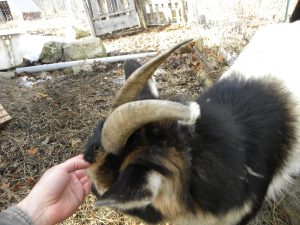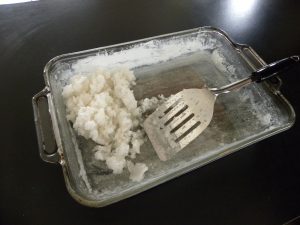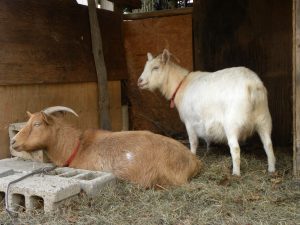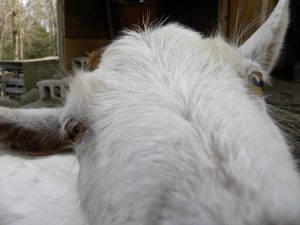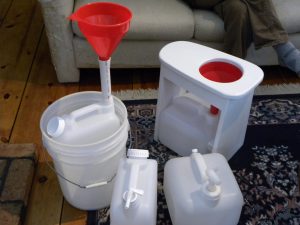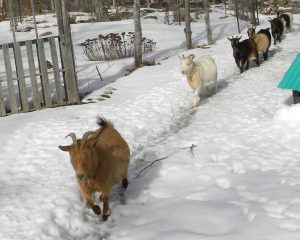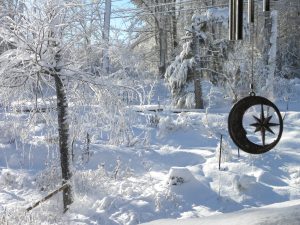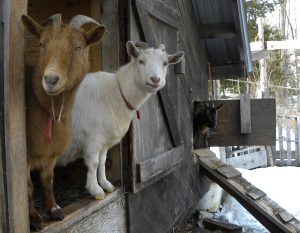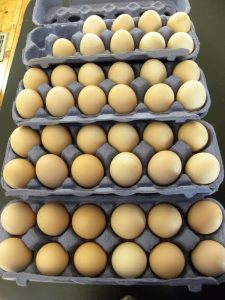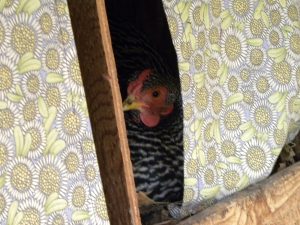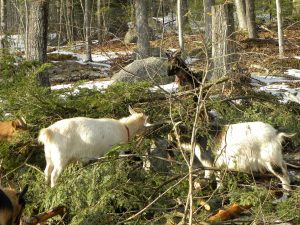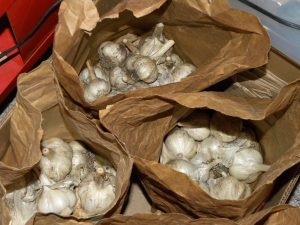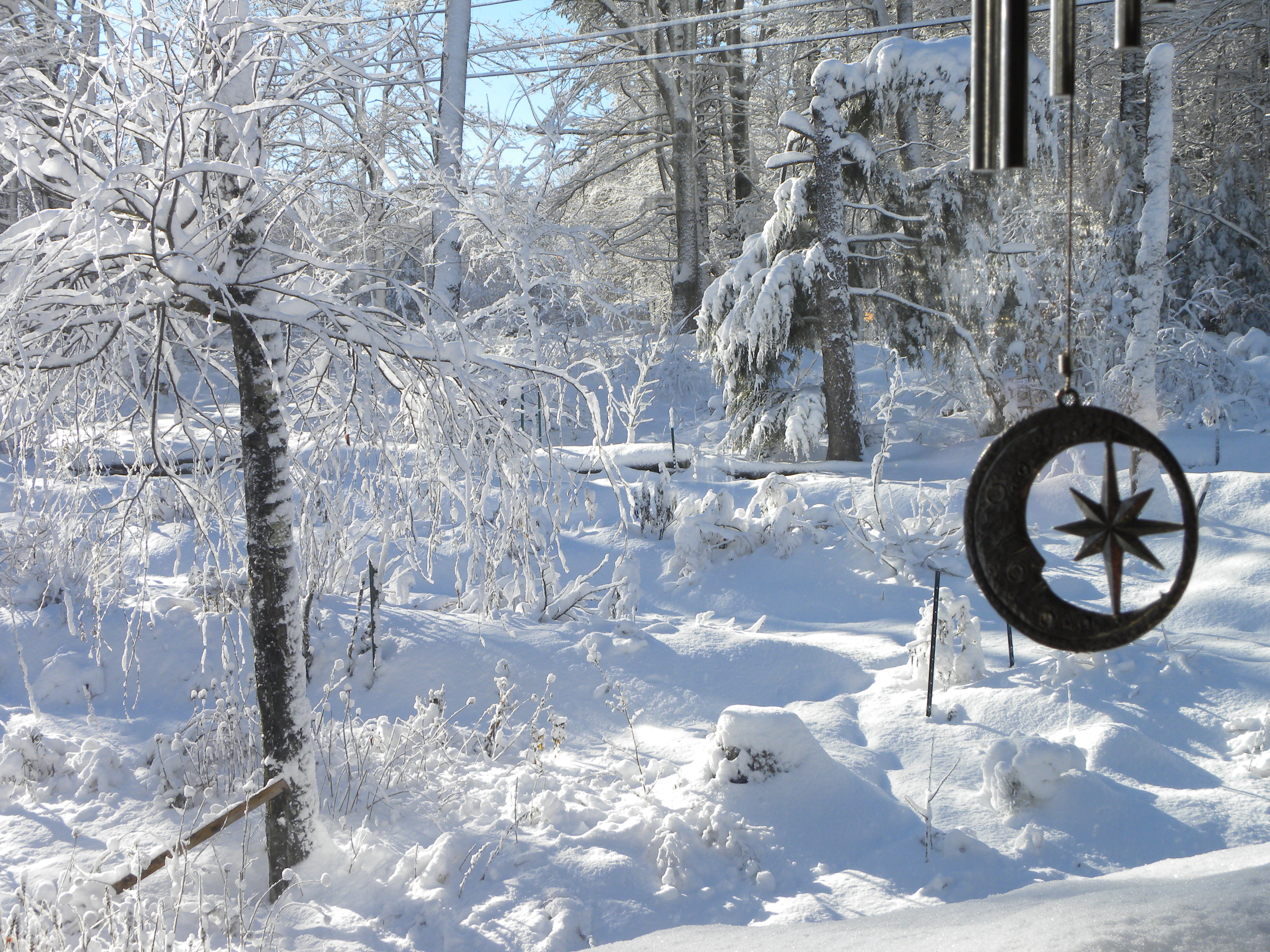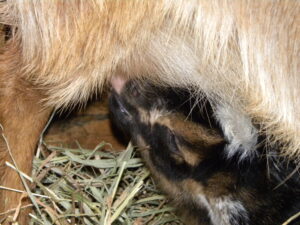Here at the end of March it is starting to feel like spring, but most of the month was unmistakably winter, with four nor-easters hitting us over the course of the month. Although we didn’t love moving all that heavy snow or having the animals more confined, at least this puts us near the normal range for precipitation this year – no drought yet in 2018!
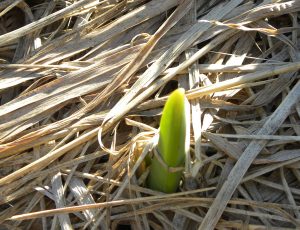
Garlic Emerging in Spring
Signs of spring include: songbirds returning (a flock of bluebirds and another of goldfinches frequent our yard), buds swelling on the trees, perennials greening, and spring bulbs, including garlic, emerging.
Our Work in March
Indoor work continued this month, feeding the fire while starting seeds and making salt. We also stack other functions with the wood stove such as drying all our laundry next to it and doing cooking and water heating on it.
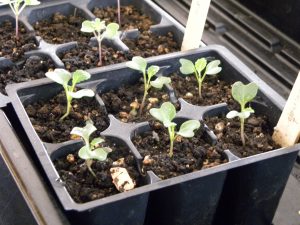
Kale Seedlings
I started leeks, kale, collards, brussel sprouts, lettuce, and eggplant. Germination seemed slow at first, but is finally taking off.
March is the best time for pruning many of our fruit trees and bushes. Before all the storms we got much of it done, getting back to it after the significant melting wrapping up March. Pruning has been very intimidating to us. It feels like one wrong cut and that could be the end of the plant we already invested years into! And with such a diversity of plants here we have to learn how to approach each one. That includes: peach, nectarine, pear, persimmons, mulberries, blueberries, honeyberries, currants, gooseberries, clove currants, jostaberries, hardy kiwis, nanking cherries, sand cherries, beach plums, goumi, raspberries, and grapes. We re-read Lee Reich‘s The Pruning Book, watched a few videos, and got out there. Steve is feeling more confident about the trees, and I seem to be understanding the bushes and cane
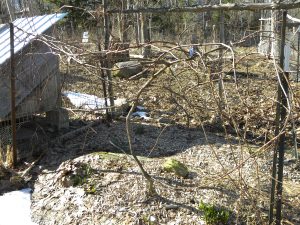
Grapes in Need of Pruning
fruits well. The grapes continue to confuse us. They just never seem to look like they do in the books once we get out there! I expect that the more we do this and watch the results the more we’ll gain understanding and confidence.
The winter can be hard on our fencing, with snow load causing collapses, branches falling and animal incursions. Steve had repairs to do, then another line of fencing to add for another goat pasture. When we started with goats, we never intended to keep bucks. I planned to rent them for the breeding season. Now that we do have our own boys, we needed an appropriate area for them. The new barn has a stall for them and there is now a large, well-fenced area for their yard that shares no fence line with the females. We don’t have a rotation system for them in place yet, but we can add that. Their pasture is actually a young woody, brushy area with very little grass which means it will be slow to cause a build up of parasites for them.
Off-farm I spent time connecting with people in meaningful ways, on issues that matter to me. This felt especially important since my March reading included The Village Effect by Susan Pinker. It presents fascinating research and stories about how crucial and healthy it is for people to come together. I led a Spring Equinox circle dance, a performance of my frame drumming group, and an extra storytelling workshop focusing on immigration. I was happy to teach about soil building to an enthusiastic group at the NOFA-NH Winter Conference and hear other great speakers and teachers, such as Dr. Daphne Miller. I put in extra time with NH Peace Action and Seacoast Permaculture as well.
Harvest
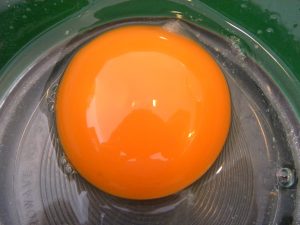
Check out that deep orange egg yolk from our ducks!
We continue to get the most from our animals rather than plants at this time of year. We brought in 241 chicken eggs, 119 duck eggs, and 5.2 gallons of milk. It’s a high production time for the poultry, but a low season for milk. Usually we breed for kids in April, but Lily’s due date is in May this year.
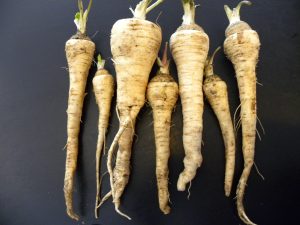
Unexpected Parsnips
When we prepped the green house for planting, we discovered a crop of parsnips! These had seeded themselves last year and didn’t seem to be growing many greens, however they made these nice roots for us. I think we’ll try that on purpose this summer into fall.
Our shelves are getting barer. We finished the winter squash and carrots. We have enough potatoes left for one more good meal. We only have a few more birds in the freezer. Canned fruit and jam remains, as does dried beans, dehydrated kale, and popcorn.
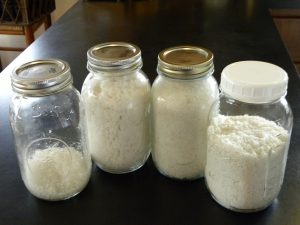
Putting Up Salt
The salt making has been a lot of fun. I have about 3 quarts, plenty for daily use and lacto-fermenting. It inspired me to start reading Mark Kurlansky’s book Salt: A World History, which I’m enjoying.
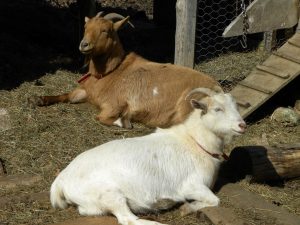
Goats Sunning Themselves
March is a great month for solar gain. The sun has moved higher and stays up longer, and the trees haven’t leafed out yet. We made 435 kwh from our PV solar panels and had quite a few cold but sunny days when we didn’t need to start the wood stove until after dark. The animals gain some heat, too!
Losses
We also have a loss to report this month… our duck flock shrunk from 9 to 8. One of the girls just disappeared. We searched, but the ducks cover a very large area so we definitely could have missed a dead one. We suspect, though, that a raptor took her. We’ve been on the lookout for other predators or issues but haven’t seen any. As long as it’s not a pattern that will decimate the flock we are willing to humbly accept small tithes to the other creatures who also have a right to live here. Still – I do love the ducks and was sad to lose one and really worried about those left. We could confine the ducks more for better control and safety, but we get so much more out of them this way for now, we’ll take the risk and let the ducks be ducks (as Joel Salatin might say).
Coming up in April
We’ll start many more seedlings, and even plant outdoors. Egg incubation is planned, including some under an already broody hen. My new packages of bees are due to arrive April 8. I’ll be hoping to wrap up some indoor work, including getting most of Seacoast Permaculture’s events through the fall scheduled. As weather permits, we’ll be outside more and more, hoping that our winter work set us up well for a productive season.
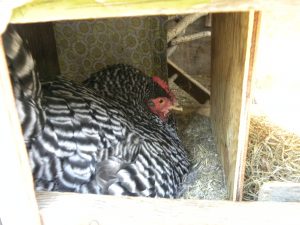
A Broody Hen

